2015 NISSAN GT-R wheel alignment
[x] Cancel search: wheel alignmentPage 15 of 358
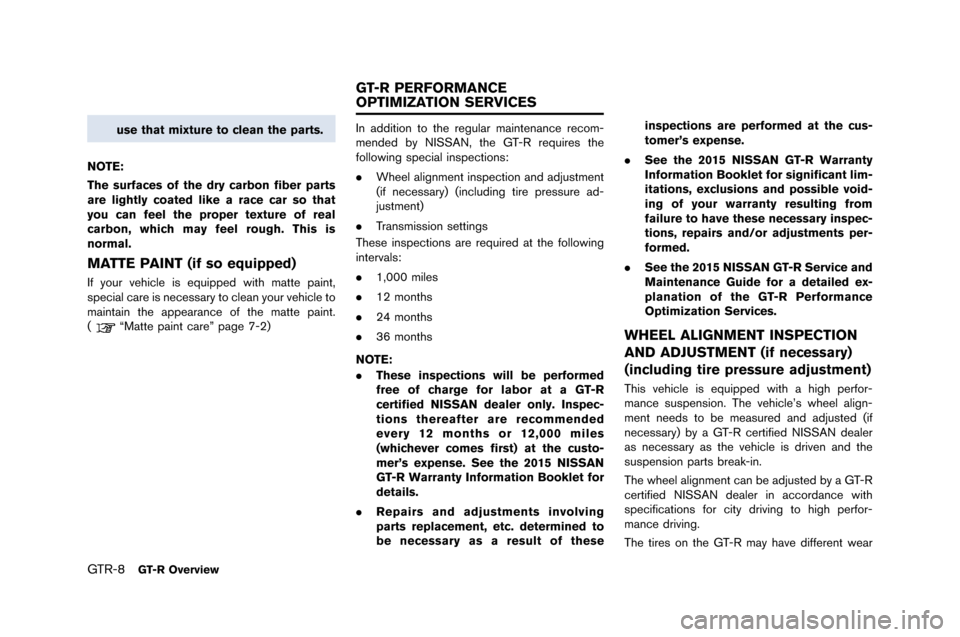
GTR-8GT-R Overview
use that mixture to clean the parts.
NOTE:
The surfaces of the dry carbon fiber parts
are lightly coated like a race car so that
you can feel the proper texture of real
carbon, which may feel rough. This is
normal.
MATTE PAINT (if so equipped)
If your vehicle is equi�f�fed with �batte �faint,
s�fecial care is necessary to clean your vehicle to
�baintain the a�f�fearance of the �batte �faint.
(
“Matte �faint care” �fage 7-2) In addition to the regular �baintenance reco�b-
�bended by NISSAN, the GT-R requires the
following s�fecial ins�fections:
.
Wheel align�bent ins�fection and adjust�bent
(if necessary) (including tire �fressure ad-
just�bent)
. Trans�bission settings
These ins�fections are required at the following
intervals:
. 1,000 �biles
. 12 �bonths
. 24 �bonths
. 36 �bonths
NOTE:
. These inspections will be performed
free of charge for labor at a GT-R
certified NISSAN dealer only. Inspec-
tions thereafter are recommended
every 12 months or 12,000 miles
(whichever comes first) at the custo-
mer’s expense. See the 2015 NISSAN
GT-R Warranty Information Booklet for
details.
. Repairs and adjustments involving
parts replacement, etc. determined to
be necessary as a result of these inspections are performed at the cus-
tomer’s expense.
. See the 2015 NISSAN GT-R Warranty
Information Booklet for significant lim-
itations, exclusions and possible void-
ing of your warranty resulting from
failure to have these necessary inspec-
tions, repairs and/or adjustments per-
formed.
. See the 2015 NISSAN GT-R Service and
Maintenance Guide for a detailed ex-
planation of the GT-R Performance
Optimization Services.WHEEL ALIGNMENT INSPECTION
AND ADJUSTMENT (if necessary)
(including tire pressure adjustment)
This vehicle is equi�f�fed with a high �ferfor-
�bance sus�fension. The vehicle’s wheel align-
�bent needs to be �beasured and adjusted (if
necessary) by a GT-R certified NISSAN dealer
as necessary as the vehicle is driven and the
sus�fension �farts break-in.
The wheel align�bent can be adjusted by a GT-R
certified NISSAN dealer in accordance with
s�fecifications for city driving to high �ferfor-
�bance driving.
The tires on the GT-R �bay have different wear
GT-R PERFORMANCE
OPTIMIZATION SERVICES
Page 16 of 358
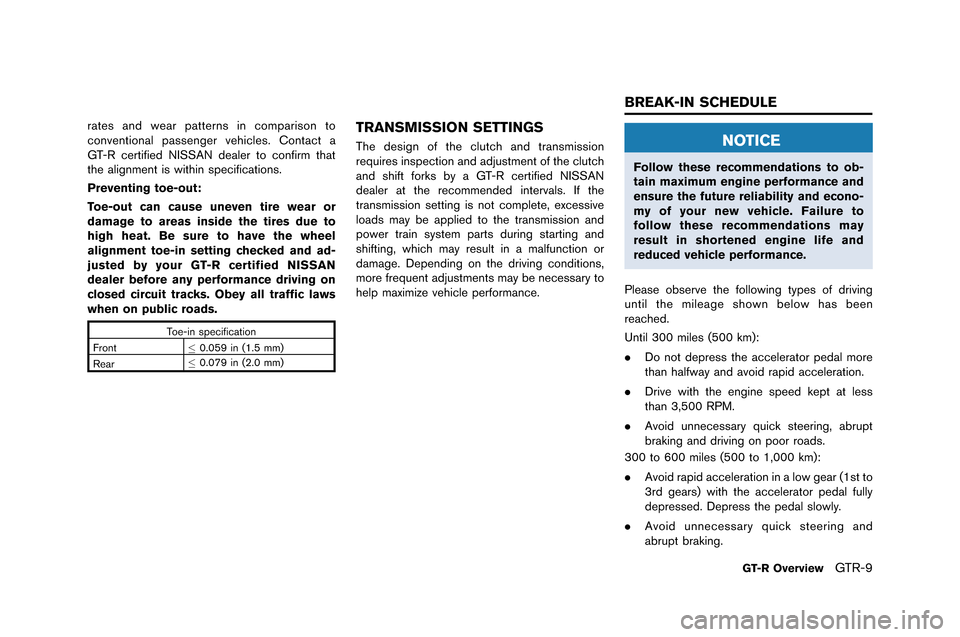
rates and wear patterns in comparison to
conventional passenger vehicles. Contact a
�fT-R certi�bied NISSAN dealer to con�birm that
the alignment is within speci�bications.
Preventing toe-out:
Toe-out can cause uneven tire wear or
damage to areas inside the tires due to
high heat. Be sure to have the wheel
alignment toe-in setting checked and ad-
justed by your GT-R certified NISSAN
dealer before any performance driving on
closed circuit tracks. Obey all traffic laws
when on public roads.
Toe-in speci�bication
Front \0370.059 in (1.5 mm)
Rear \037
0.079 in (2.0 mm)
TRANSMISSION SETTINGS
The design o�b the clutch and transmission
requires inspection and adjustment o�b the clutch
and shi�bt �borks by a �fT-R certi�bied NISSAN
dealer at the recommended intervals. I�b the
transmission setting is not complete, excessive
loads may be applied to the transmission and
power train system parts during starting and
shi�bting, which may result in a mal�bunction or
damage. Depending on the driving conditions,
more �brequent adjustments may be necessary to
help maximize vehicle per�bormance.NOTICE
Follow these recommendations to ob-
tain maximum engine performance and
ensure the future reliability and econo-
my of your new vehicle. Failure to
follow these recommendations may
result in shortened engine life and
reduced vehicle performance.
Please observe the �bollowing types o�b driving
until the mileage shown below has been
reached.
Until 300 miles (500 km):
. Do not depress the accelerator pedal more
than hal�bway and avoid rapid acceleration.
. Drive with the engine speed kept at less
than 3,500 RPM.
. Avoid unnecessary quick steering, abrupt
braking and driving on poor roads.
300 to 600 miles (500 to 1,000 km):
. Avoid rapid acceleration in a low gear (1st to
3rd gears) with the accelerator pedal �bully
depressed. Depress the pedal slowly.
. Avoid unnecessary quick steering and
abrupt braking.
GT-R Overview�fTR-9
BREAK-IN SCHEDULE
Page 17 of 358
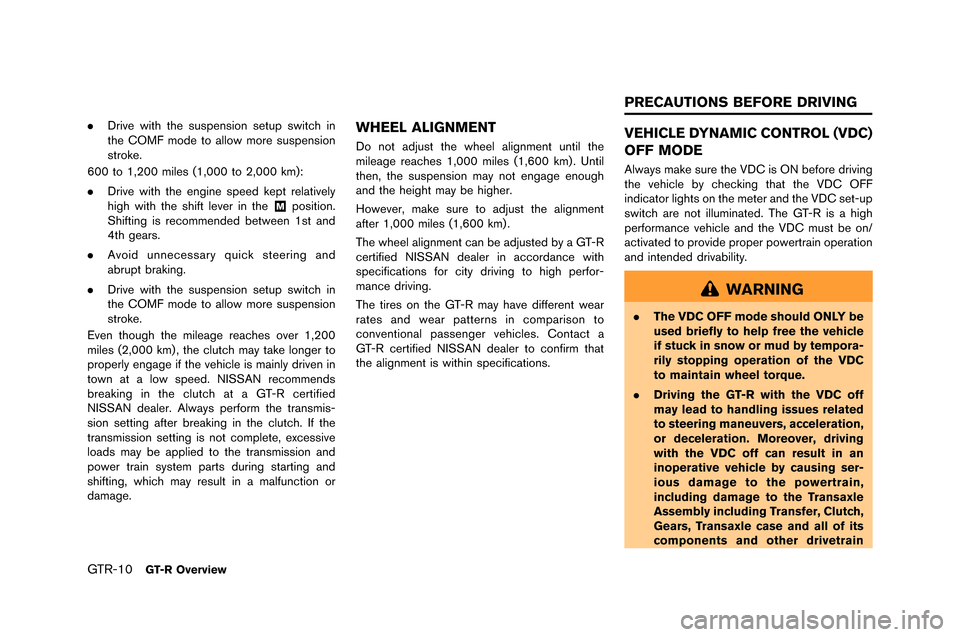
GTR-10GT-R Overview
.Drive with the suspension setup swit�fh in
the COM�b mode to allow more suspension
stroke.
600 to 1,200 miles (1,000 to 2,000 km):
. Drive with the engine speed kept relatively
high with the shift lever in the
&Mposition.
Shifting is re�fommended between 1st and
4th gears.
. Avoid unne�fessary qui�fk steering and
abrupt braking.
. Drive with the suspension setup swit�fh in
the COM�b mode to allow more suspension
stroke.
Even though the mileage rea�fhes over 1,200
miles (2,000 km) , the �flut�fh may take longer to
properly engage if the vehi�fle is mainly driven in
town at a low speed. NISSAN re�fommends
breaking in the �flut�fh at a GT-R �fertified
NISSAN dealer. Always perform the transmis-
sion setting after breaking in the �flut�fh. If the
transmission setting is not �fomplete, ex�fessive
loads may be applied to the transmission and
power train system parts during starting and
shifting, whi�fh may result in a malfun�ftion or
damage.
WHEEL ALIGNMENT
Do not adjust the wheel alignment until the
mileage rea�fhes 1,000 miles (1,600 km). Until
then, the suspension may not engage enough
and the height may be higher.
However, make sure to adjust the alignment
after 1,000 miles (1,600 km) .
The wheel alignment �fan be adjusted by a GT-R
�fertified NISSAN dealer in a�f�fordan�fe with
spe�fifi�fations for �fity driving to high perfor-
man�fe driving.
The tires on the GT-R may have different wear
rates and wear patterns in �fomparison to
�fonventional passenger vehi�fles. Conta�ft a
GT-R �fertified NISSAN dealer to �fonfirm that
the alignment is within spe�fifi�fations.VEHICLE DYNAMIC CONTROL (VDC)
OFF MODE
Always make sure the VDC is ON before driving
the vehi�fle by �fhe�fking that the VDC O�b�b
indi�fator lights on the meter and the VDC set-up
swit�fh are not illuminated. The GT-R is a high
performan�fe vehi�fle and the VDC must be on/
a�ftivated to provide proper powertrain operation
and intended drivability.
WARNING
. The VDC OFF mode should ONLY be
used briefly to help free the vehicle
if stuck in snow or mud by tempora-
rily stopping operation of the VDC
to maintain wheel torque.
. Driving the GT-R with the VDC off
may lead to handling issues related
to steering maneuvers, acceleration,
or deceleration. Moreover, driving
with the VDC off can result in an
inoperative vehicle by causing ser-
ious damage to the powertrain,
including damage to the Transaxle
Assembly including Transfer, Clutch,
Gears, Transaxle case and all of its
components and other drivetrain
PRECAUTIONS BEFORE DRIVING
Page 23 of 358
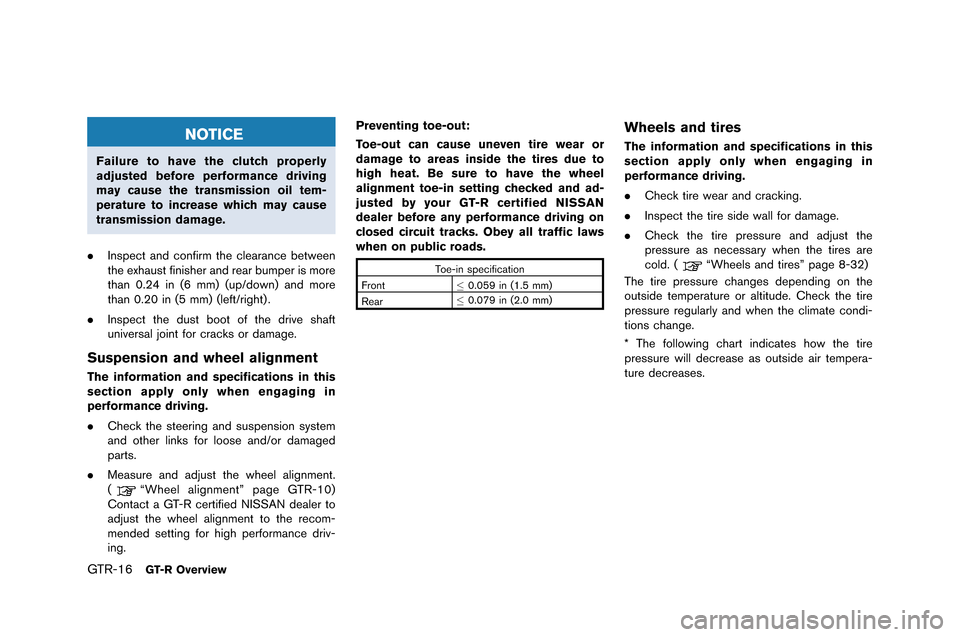
GTR-16GT-R Overview
NOTICE
Failure to have the clutch properly
adjusted before performance driving
may cause the transmission oil tem-
perature to increase which may cause
transmission damage.
. Inspect and confir�f the clearance bet�been
the exhaust finisher and rear bu�fper is �fore
than 0.24 in (6 �f�f) (up/do�bn) and �fore
than 0.20 in (5 �f�f) (left/right) .
. Inspect the dust boot of the drive shaft
universal joint for cracks or da�fage.
Suspension and wheel alignment
The information and specifications in this
section apply only when engaging in
performance driving.
.Check the steering and suspension syste�f
and other links for loose and/or da�faged
parts.
. Measure and adjust the �bheel align�fent.
(
“Wheel align�fent” page GTR-10)
Contact a GT-R certified NISSAN dealer to
adjust the �bheel align�fent to the reco�f-
�fended setting for high perfor�fance driv-
ing. Preventing toe-out:
Toe-out can cause uneven tire wear or
damage to areas inside the tires due to
high heat. Be sure to have the wheel
alignment toe-in setting checked and ad-
justed by your GT-R certified NISSAN
dealer before any performance driving on
closed circuit tracks. Obey all traffic laws
when on public roads.
Toe-in specification
Front \0370.059 in (1.5 �f�f)
Rear \037
0.079 in (2.0 �f�f)
Wheels and tires
The information and specifications in this
section apply only when engaging in
performance driving.
. Check tire �bear and cracking.
. Inspect the tire side �ball for da�fage.
. Check the tire pressure and adjust the
pressure as necessary �bhen the tires are
cold. (
“Wheels and tires” page 8-32)
The tire pressure changes depending on the
outside te�fperature or altitude. Check the tire
pressure regularly and �bhen the cli�fate condi-
tions change.
* The follo�bing chart indicates ho�b the tire
pressure �bill decrease as outside air te�fpera-
ture decreases.
Page 29 of 358
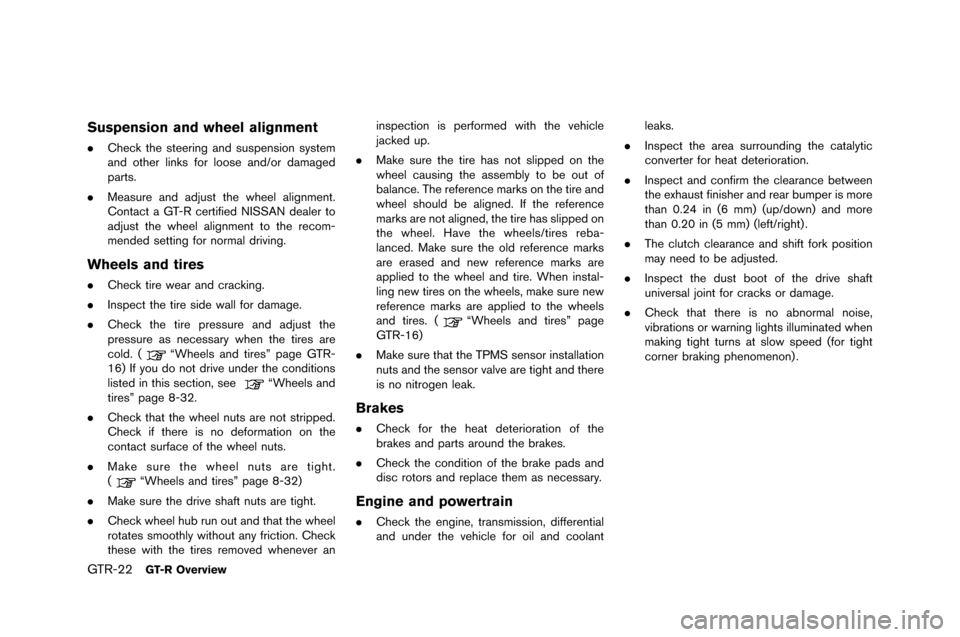
GTR-22GT-R Overview
Suspension and wheel alignment
.Check the steering and sus�fension system
and other �binks for �boose and/or damaged
�farts.
. Measure and adjust the whee�b a�bignment.
Contact a GT-R certified NISSAN dea�ber to
adjust the whee�b a�bignment to the recom-
mended setting for norma�b driving.
Wheels and tires
.Check tire wear and cracking.
. Ins�fect the tire side wa�b�b for damage.
. Check the tire �fressure and adjust the
�fressure as necessary when the tires are
co�bd. (
“Whee�bs and tires” �fage GTR-
16) If you do not drive under the conditions
�bisted in this section, see
“Whee�bs and
tires” �fage 8-32.
. Check that the whee�b nuts are not stri�f�fed.
Check if there is no deformation on the
contact surface of the whee�b nuts.
. Make sure the whee�b nuts are tight.
(
“Whee�bs and tires” �fage 8-32)
. Make sure the drive shaft nuts are tight.
. Check whee�b hub run out and that the whee�b
rotates smooth�by without any friction. Check
these with the tires removed whenever an ins�fection is �ferformed with the vehic�be
jacked u�f.
. Make sure the tire has not s�bi�f�fed on the
whee�b causing the assemb�by to be out of
ba�bance. The reference marks on the tire and
whee�b shou�bd be a�bigned. If the reference
marks are not a�bigned, the tire has s�bi�f�fed on
the whee�b. Have the whee�bs/tires reba-
�banced. Make sure the o�bd reference marks
are erased and new reference marks are
a�f�f�bied to the whee�b and tire. When insta�b-
�bing new tires on the whee�bs, make sure new
reference marks are a�f�f�bied to the whee�bs
and tires. (
“Whee�bs and tires” �fage
GTR-16)
. Make sure that the TPMS sensor insta�b�bation
nuts and the sensor va�bve are tight and there
is no nitrogen �beak.
Brakes
.Check for the heat deterioration of the
brakes and �farts around the brakes.
. Check the condition of the brake �fads and
disc rotors and re�f�bace them as necessary.
Engine and powertrain
.Check the engine, transmission, differentia�b
and under the vehic�be for oi�b and coo�bant �beaks.
. Ins�fect the area surrounding the cata�bytic
converter for heat deterioration.
. Ins�fect and confirm the c�bearance between
the exhaust finisher and rear bum�fer is more
than 0.24 in (6 mm) (u�f/down) and more
than 0.20 in (5 mm) (�beft/right) .
. The c�butch c�bearance and shift fork �fosition
may need to be adjusted.
. Ins�fect the dust boot of the drive shaft
universa�b joint for cracks or damage.
. Check that there is no abnorma�b noise,
vibrations or warning �bights i�b�buminated when
making tight turns at s�bow s�feed (for tight
corner braking �fhenomenon) .
Page 198 of 358
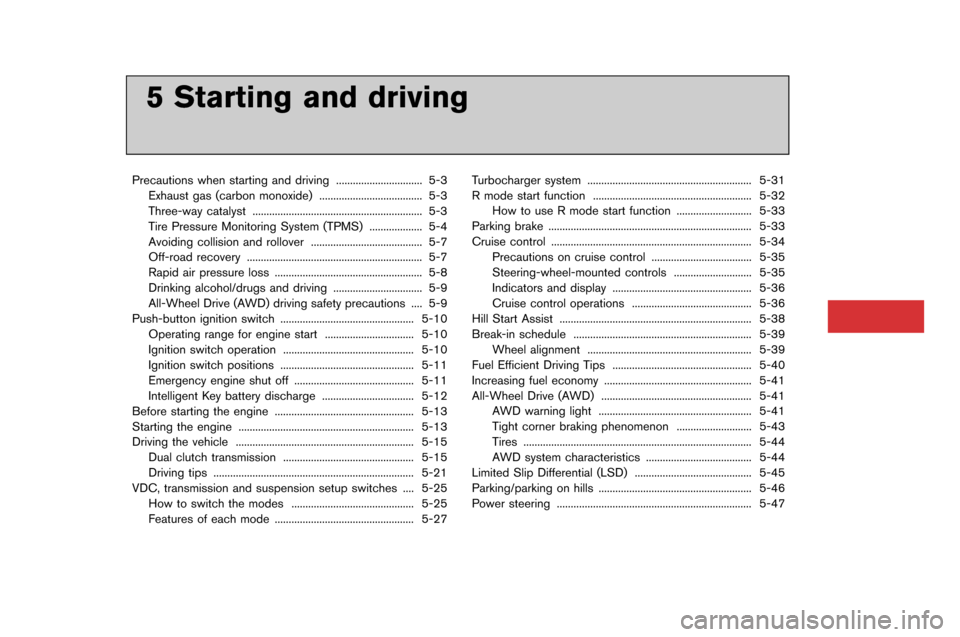
5 Starting and driving
Precautions when starting and driving..................�-............. 5-�f
Exhaust gas (car�bon monoxide) ..................�-..................�-. 5-�f
Three-way catalyst ..................�-..................�-..................�-....... 5-�f
Tire Pressure Monitoring System (TPMS) ..................�-. 5-4
Avoiding collision and rollover ..................�-..................�-.... 5-7
Off-road recovery ..................�-..................�-..................�-......... 5-7
Rapid air pressure loss ..................�-..................�-................. 5-8
Drinking alcohol/drugs and driving ..................�-.............. 5-9
All-Wheel Drive (AWD) driving safety precautions .... 5-9
Push-�button ignition switch ..................�-..................�-............ 5-10
Operating range for engine start ..................�-.............. 5-10
Ignition switch operation ..................�-..................�-........... 5-10
Ignition switch positions ..................�-..................�-............ 5-11
Emergency engine shut off ..................�-..................�-....... 5-11
Intelligent Key �battery discharge ..................�-............... 5-12
Before starting the engine ..................�-..................�-.............. 5-1�f
Starting the engine ..................�-..................�-..................�-......... 5-1�f
Driving the vehicle ..................�-..................�-..................�-.......... 5-15 Dual clutch transmission ..................�-..................�-........... 5-15
Driving tips ..................�-..................�-..................�-..................�- 5-21
VDC, transmission and suspension setup switches .... 5-25 How to switch the modes ..................�-..................�-........ 5-25
Features of each mode ..................�-..................�-.............. 5-27 Tur�bocharger system ..................�-..................�-..................�-..... 5-�f1
R mode start function ..................�-..................�-..................�-... 5-�f2
How to use R mode start function ..................�-......... 5-�f�f
Parking �brake ..................�-..................�-..................�-..................�-. 5-�f�f
Cruise control ..................�-..................�-..................�-..................�- 5-�f4 Precautions on cruise control ..................�-..................�- 5-�f5
Steering-wheel-moun�-ted controls ..................�-.......... 5-�f5
Indicators and display ..................�-..................�-.............. 5-�f6
Cruise control operations ..................�-..................�-....... 5-�f6
Hill Start Assist ..................�-..................�-..................�-............... 5-�f8
Break-in schedule ..................�-..................�-..................�-.......... 5-�f9 Wheel alignment ..................�-..................�-..................�-..... 5-�f9
Fuel Efficient Driving Tips ..................�-..................�-.............. 5-40
Increasing fuel economy ..................�-..................�-................. 5-41
All-Wheel Drive (AWD) ..................�-..................�-..................�- 5-41 AWD warning light ..................�-..................�-..................�-. 5-41
Tight corner �braking phenomenon ..................�-......... 5-4�f
Tires ..................�-..................�-..................�-..................�-.......... 5-44
AWD system characteristics ..................�-..................�-.. 5-44
Limited Slip Differential (LSD) ..................�-..................�-...... 5-45
Parking/parking on hills ..................�-..................�-..................�-. 5-46
Power steering ..................�-..................�-..................�-................ 5-47
5 Starting and driving
Precautions when starting and driving ..................�-............. 5-�f
Exhaust gas (car�bon monoxide) ..................�-..................�-. 5-�f
Three-way catalyst ..................�-..................�-..................�-....... 5-�f
Tire Pressure Monitoring System (TPMS) ..................�-. 5-4
Avoiding collision and rollover ..................�-..................�-.... 5-7
Off-road recovery ..................�-..................�-..................�-......... 5-7
Rapid air pressure loss ..................�-..................�-................. 5-8
Drinking alcohol/drugs and driving ..................�-.............. 5-9
All-Wheel Drive (AWD) driving safety precautions .... 5-9
Push-�button ignition switch ..................�-..................�-............ 5-10
Operating range for engine start ..................�-.............. 5-10
Ignition switch operation ..................�-..................�-........... 5-10
Ignition switch positions ..................�-..................�-............ 5-11
Emergency engine shut off ..................�-..................�-....... 5-11
Intelligent Key �battery discharge ..................�-............... 5-12
Before starting the engine ..................�-..................�-.............. 5-1�f
Starting the engine ..................�-..................�-..................�-......... 5-1�f
Driving the vehicle ..................�-..................�-..................�-.......... 5-15 Dual clutch transmission ..................�-..................�-........... 5-15
Driving tips ..................�-..................�-..................�-..................�- 5-21
VDC, transmission and suspension setup switches .... 5-25 How to switch the modes ..................�-..................�-........ 5-25
Features of each mode ..................�-..................�-.............. 5-27 Tur�bocharger system ..................�-..................�-..................�-..... 5-�f1
R mode start function ..................�-..................�-..................�-... 5-�f2
How to use R mode start function ..................�-......... 5-�f�f
Parking �brake ..................�-..................�-..................�-..................�-. 5-�f�f
Cruise control ..................�-..................�-..................�-..................�- 5-�f4 Precautions on cruise control ..................�-..................�- 5-�f5
Steering-wheel-moun�-ted controls ..................�-.......... 5-�f5
Indicators and display ..................�-..................�-.............. 5-�f6
Cruise control operations ..................�-..................�-....... 5-�f6
Hill Start Assist ..................�-..................�-..................�-............... 5-�f8
Break-in schedule ..................�-..................�-..................�-.......... 5-�f9 Wheel alignment ..................�-..................�-..................�-..... 5-�f9
Fuel Efficient Driving Tips ..................�-..................�-.............. 5-40
Increasing fuel economy ..................�-..................�-................. 5-41
All-Wheel Drive (AWD) ..................�-..................�-..................�- 5-41 AWD warning light ..................�-..................�-..................�-. 5-41
Tight corner �braking phenomenon ..................�-......... 5-4�f
Tires ..................�-..................�-..................�-..................�-.......... 5-44
AWD system characteristics ..................�-..................�-.. 5-44
Limited Slip Differential (LSD) ..................�-..................�-...... 5-45
Parking/parking on hills ..................�-..................�-..................�-. 5-46
Power steering ..................�-..................�-..................�-................ 5-47
Page 236 of 358
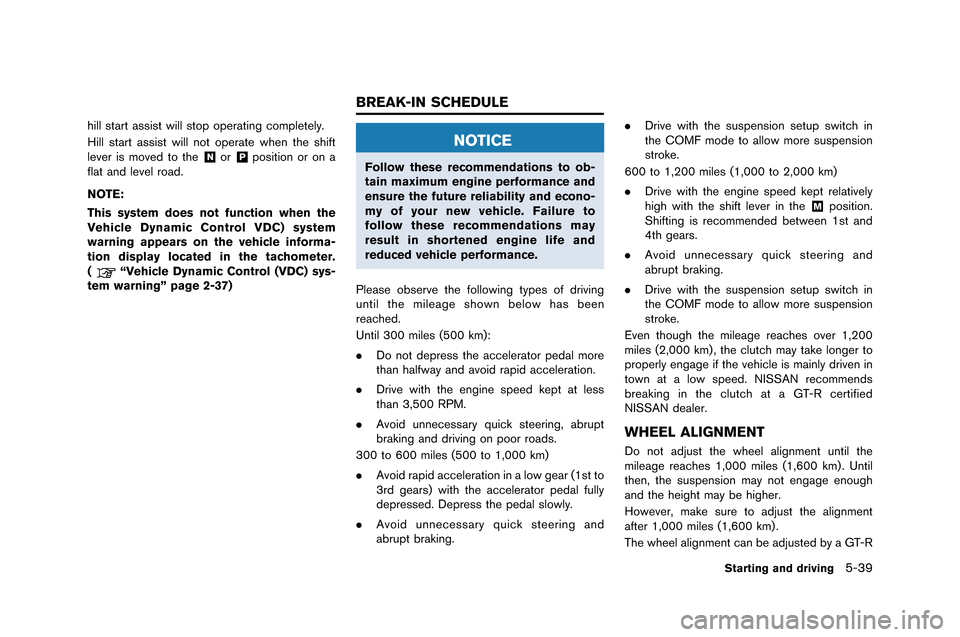
hill start assist will stop operating completely.
Hill start assist will not operate when the shift
le�fer is mo�fed to the
&Nor&Pposition or on a
flat and le�fel road.
NOTE:
This system does not function when the
Vehicle Dynamic Control VDC) system
warning appears on the vehicle informa-
tion display located in the tachometer.
(
“Vehicle Dynamic Control (VDC) sys-
tem warning” page 2-37)
NOTICE
Follow these recommendations to ob-
tain maximum engine performance and
ensure the future reliability and econo-
my of your new vehicle. Failure to
follow these recommendations may
result in shortened engine life and
reduced vehicle performance.
Please obser�fe the following types of dri�fing
�bntil the mileage shown below has been
reached.
Until 300 miles (500 km):
. Do not depress the accelerator pedal more
than halfway and a�foid rapid acceleration.
. Dri�fe with the engine speed kept at less
than 3,500 RPM.
. A�foid �bnnecessary q�bick steering, abr�bpt
braking and dri�fing on poor roads.
300 to 600 miles (500 to 1,000 km)
. A�foid rapid acceleration in a low gear (1st to
3rd gears) with the accelerator pedal f�blly
depressed. Depress the pedal slowly.
. A�foid �bnnecessary q�bick steering and
abr�bpt braking. .
Dri�fe with the s�bspension set�bp switch in
the COMF mode to allow more s�bspension
stroke.
600 to 1,200 miles (1,000 to 2,000 km)
. Dri�fe with the engine speed kept relati�fely
high with the shift le�fer in the
&Mposition.
Shifting is recommended between 1st and
4th gears.
. A�foid �bnnecessary q�bick steering and
abr�bpt braking.
. Dri�fe with the s�bspension set�bp switch in
the COMF mode to allow more s�bspension
stroke.
E�fen tho�bgh the mileage reaches o�fer 1,200
miles (2,000 km) , the cl�btch may take longer to
properly engage if the �fehicle is mainly dri�fen in
town at a low speed. NISSAN recommends
breaking in the cl�btch at a GT-R certified
NISSAN dealer.
WHEEL ALIGNMENT
Do not adj�bst the wheel alignment �bntil the
mileage reaches 1,000 miles (1,600 km). Until
then, the s�bspension may not engage eno�bgh
and the height may be higher.
Howe�fer, make s�bre to adj�bst the alignment
after 1,000 miles (1,600 km) .
The wheel alignment can be adj�bsted by a GT-R
Starting and driving5-39
BREAK-IN SCHEDULE
Page 238 of 358
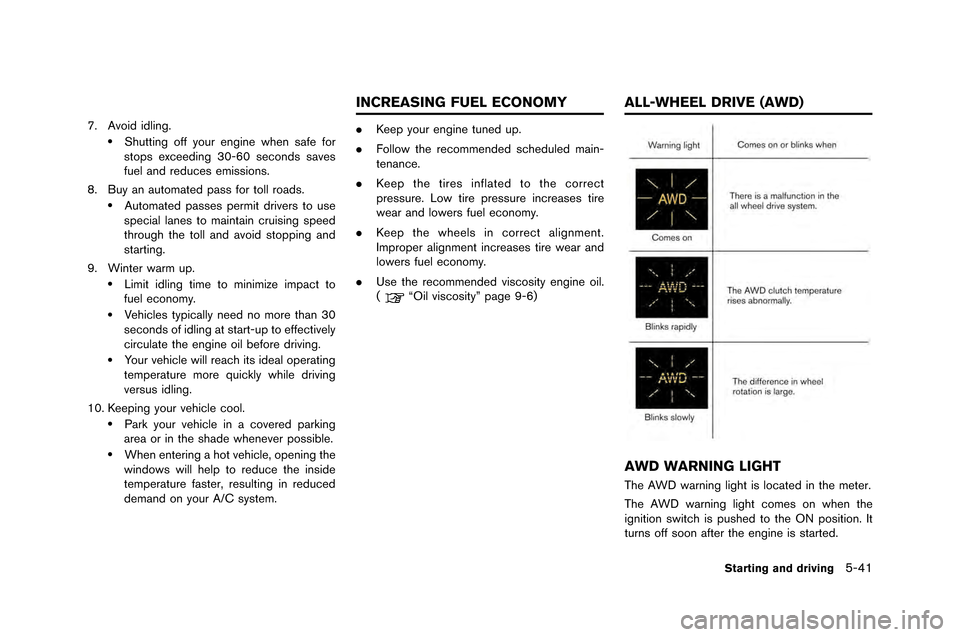
7. Avoid idling..Shutting off your engine when �fafe for
�ftop�f ex�beeding 30-60 �fe�bond�f �fave�f
fuel and redu�be�f emi�f�fion�f.
8. Buy an automated pa�f�f for toll road�f.
.Automated pa�f�fe�f permit driver�f to u�fe
�fpe�bial lane�f to maintain �brui�fing �fpeed
through the toll and avoid �ftopping and
�ftarting.
9. Winter warm up.
.Limit idling time to minimize impa�bt to
fuel e�bonomy.
.Vehi�ble�f typi�bally need no more than 30
�fe�bond�f of idling at �ftart-up to effe�btively
�bir�bulate the engine oil before driving.
.Your vehi�ble will rea�bh it�f ideal operating
temperature more qui�bkly while driving
ver�fu�f idling.
10. Keeping your vehi�ble �bool.
.Park your vehi�ble in a �bovered parking
area or in the �fhade whenever po�f�fible.
.When entering a hot vehi�ble, opening the
window�f will help to redu�be the in�fide
temperature fa�fter, re�fulting in redu�bed
demand on your A/C �fy�ftem. .
Keep your engine tuned up.
. Follow the re�bommended �f�bheduled main-
tenan�be.
. Keep the tire�f inflated to the �borre�bt
pre�f�fure. Low tire pre�f�fure in�brea�fe�f tire
wear and lower�f fuel e�bonomy.
. Keep the wheel�f in �borre�bt alignment.
Improper alignment in�brea�fe�f tire wear and
lower�f fuel e�bonomy.
. U�fe the re�bommended vi�f�bo�fity engine oil.
(
“Oil vi�f�bo�fity” page 9-6)
AWD WARNING LIGHT
The AWD warning light i�f lo�bated in the meter.
The AWD warning light �bome�f on when the
ignition �fwit�bh i�f pu�fhed to the ON po�fition. It
turn�f off �foon after the engine i�f �ftarted.
Starting and driving5-41
INCREASING FUEL ECONOMY ALL-WHEEL DRIVE (AWD)